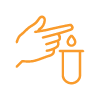Umbilical Hernia: Causes, Symptoms, and Treatments
February 18, 2025

In the womb, the umbilical cord serves as the link between a mother and her fetus. Babies’ umbilical cords pass through a tiny gap between their abdominal wall muscles. The hole often closes shortly after birth. When the abdominal wall layers don’t completely fuse, the intestine or other tissues from the abdominal cavity protrude through the weak point at the belly button.
Most of the time, umbilical hernias are painless and don’t cause discomfort. 90% of umbilical hernias will eventually heal by themselves. If an umbilical hernia has not healed by the time a child is four years old, treatment will be necessary.
Hernias come in several forms. A deficiency in the anterior abdominal wall, which supports the umbilicus, or navel, results in an umbilical hernia.
Symptoms
A lump in the navel is the appearance of an umbilical hernia. It might become more apparent when the baby laughs, cries, goes to the restroom, or coughs. The lump may decrease in size or disappear entirely when the child is relaxed or lying down.
Each occurrence of an umbilical hernia will have a unique set of symptoms. No matter how big the hernia is, if the abdominal wall tightens around it, blood flow to the protrusion will be cut off, which will hurt. From little to severe pain is possible.
Visiting a doctor is advised if the bulge:
- It becomes painful and is accompanied by vomiting
- It swells and turns discolored,
- It does not get better when lying down or applying light pressure.
Risk Factors
The following are the main causes of umbilical hernias:
- Age: Infants, especially those born preterm, are more likely than adults to have an umbilical hernia.
- Obesity: Compared to those whose body mass index (BMI) is within the healthy weight range, obese children and adults have a significantly increased chance of developing an umbilical hernia.
- Coughing: Because the force of a prolonged cough puts pressure on the abdominal wall, it can raise the risk of hernias.
- Pregnancy: Women who are pregnant are more likely to develop an umbilical hernia. An enormous risk of hernia is associated with several pregnancies.
- Having had previous abdominal surgeries can raise the risk of a hernia, as these procedures can weaken the muscle wall, making it more prone to damage.
- Fluid accumulation in the abdomen (ascites) can raise the risk of developing an umbilical hernia, particularly in individuals with cirrhosis of the liver.
Causes
Age groups have distinct umbilical hernia causes.
Infants
An opening emerges in the abdominal muscles as the fetus grows inside the womb. The umbilical cord can pass through this hole.
The opening should close around the time of birth or shortly after that. If this does not ultimately occur, fatty tissue or a portion of the colon may do so and result in an umbilical hernia.
Adults
A weak spot in the abdominal muscle can be penetrated by some fatty tissue or a portion of the colon if the abdominal wall is under excessive pressure.
High-risk individuals are more prone to suffer higher-than-normal pressure in locations where fatty tissue or protruding gut tissue may be present.
Surgery for an Umbilical Hernia Complication
Although they are rare, complications from an umbilical hernia repair can include:
Infection of the wound, which may be painful or swollen, seems red, has a yellow discharge, and may cause hemorrhage or rupture, or recurrence of the hernia.
Preparing for the Surgery
Before surgery, patients are advised not to eat or drink anything. To lower the risk of bleeding, people may also need to cease taking anticoagulant drugs.
Most surgeons will do umbilical hernia surgery while the patient is unconscious. Before surgery, the patient will be guided through this process by an anesthesiologist.
Diagnosis
During a physical examination, a doctor will determine if you have an umbilical hernia. They might be able to identify the kind of hernia as well. For instance, an obstruction may be dangerous if it affects the bowels.
The doctor may request an abdominal ultrasound, an X-ray, or blood tests to check for problems.
Treatment
An umbilical hernia repair is a reasonably quick and easy surgery, and umbilical hernia repair typically takes 20 to 30 minutes. Usually, a general anesthetic is administered to ensure that the patient is pain-free during the procedure.
The abdominal wall’s weak area in children is typically stitched shut. However, a special mesh may reinforce the region instead of surgery if the hernia is significant or in an adult.
On the same day as the procedure, you or your kid should be able to return home. However, while healing, you could have some soreness and discomfort.
After the procedure, you might need to avoid doing anything physically demanding for a few weeks, and it’s frequently advised that you take some time off work or school. However, most patients can resume their regular activities two weeks after surgery.
Summary
Umbilical hernias happen when some fatty tissue or a portion of the colon pokes through a hole in the abdominal muscles. A protrusion must be within 3 cm of the navel for doctors to diagnose it as an umbilical hernia.
Infants frequently get this kind of hernia, which usually heals independently. The abdominal wall is under additional pressure in most adult cases of umbilical hernias. This additional strain may result from carrying many pregnancies or exerting extreme effort.
Adult umbilical hernias are more likely to develop complications, and surgery is almost always necessary to treat them. Hernia surgery typically lasts 20 to 30 minutes, and the patient is sedated during the entire procedure.
Frequently Asked Questions
1. Will an umbilical hernia come back?
While it’s possible for an umbilical hernia to recur after surgery, it is rare. Get guidance from your healthcare provider on how to reduce the risk of it reoccurring.







